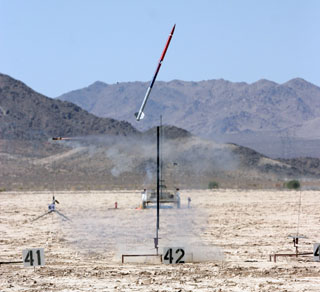Section 1 – The Final Report (Due at start of Final Presentation)
Each team will be responsible for submitting a final technical report on the rocket flights and analysis of the flight data. The team should collaborate fully on the writing of the document. In brief, the final report is a technical paper no more than nine single-spaced pages of text with 11-point type and 1-inch margins. The length limit does not include the figures, however, excessive text on the figures will be included in the length limit.
This final report is similar to research papers published in professional journals. To gain a feel for such technical papers, you may want to examine some papers in on-line professional journals.
Abstract:
An abstract should be between one and three paragraphs in length with between 100 to 400 total words. The abstract should contain specific and numerical results. It is a compression of the entire report (which can be further reduced to a single sentence, the title of the report), not a teaser or trailer. Note that, unlike the introduction (which is the next part of the report), the abstract should include a brief description of the main methodology and achievements of whole project, as well as the background and the motivation of the project.
BTW, if you compress the entire report into a set of 10 to 15 PowerPoint slides, that will be your presentation.
Introduction
The introduction should define the problem you are studying, the motivation and background of the project, survey the previous efforts and existing results, and state the importance of your efforts. If needed, basic terminology should be defined and explained. Sometimes, a second section called the "Background" can be used, in which more technical background can be discussed and additional terms defined.
Main Section of Report
The meat of the report is contained in the main section, which could be subdivided into several subsections, each addressing one specific aspect of the project. For example, you may want to have several subsections to discuss the sensor selection, hardware design, ground-based testing, flight modeling, and the processing and analysis of different types of data collected by various sensors onboard the rockets. These subdivisions are usually helpful in terms of better logic flow and readability.
You can assume the reader has some general technical/engineering background, but do not assume the reader is familiar with what you did specifically. Don’t assume the reader of your report is the teaching team for the course. Your purpose is to convey your experiments, the methodology as well as the results, to a fellow engineer in professional and technical language, to the extent that the reader could repeat the project if needed. For example, you can assume the reader is a fellow Engineering student at HMC who is not in E80 but would like to carry out some similar rocketry project, and your goal is to explain clearly what you did so that he/she does not have to ask you too many questions.
Do not describe your experimental procedure and methodology in a chronological manner. Technical writing is not storytelling. The reader is only interested in what results you achieved and how. If the time line of your effort is not relevant to the technical content, there is no need to mention it.
Mathematics and equations are an effective language to describe the technical issues in engineering; often they are more efficient than plain English in terms of conveying the concepts and ideas. (Although it takes time and training to use this language well.) Whenever possible, use mathematics to describe the theoretical background of whatever you did, because the mathematical language is the most precise and concise.
Also, take full advantage of other nonverbal means to present your data and findings, such tabulation and plotting. A picture is truly worth 1k words.
Conclusion
The conclusion is where you elucidate the results obtained during the project. As the details of the project have already been described, you should be concise here. This section is where you tell the world what all your hard work means. Make sure that all of the main points you want to make are made. You may also mention future work that you recommend, or additional directions for research suggested by your results.
Acknowledgement
If needed, you acknowledge those who helped you in the process of the project.
Reference
Use standard A.I.P reference styles. Make sure your list of references is complete.
Grading
The Final Report will be evaluated by your section professor according to the following rubric.


